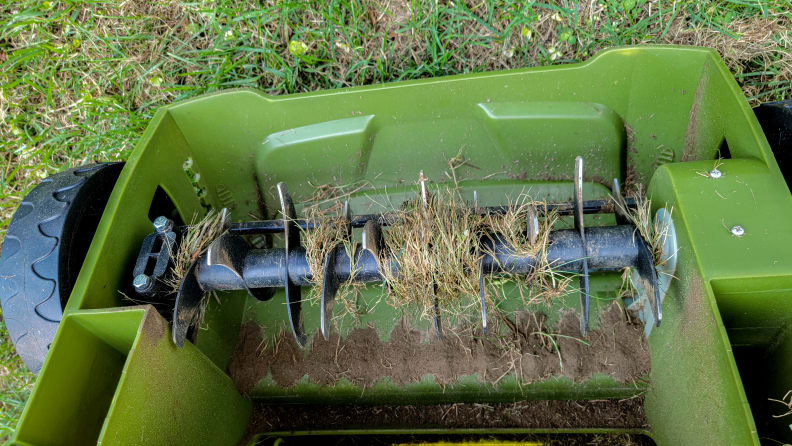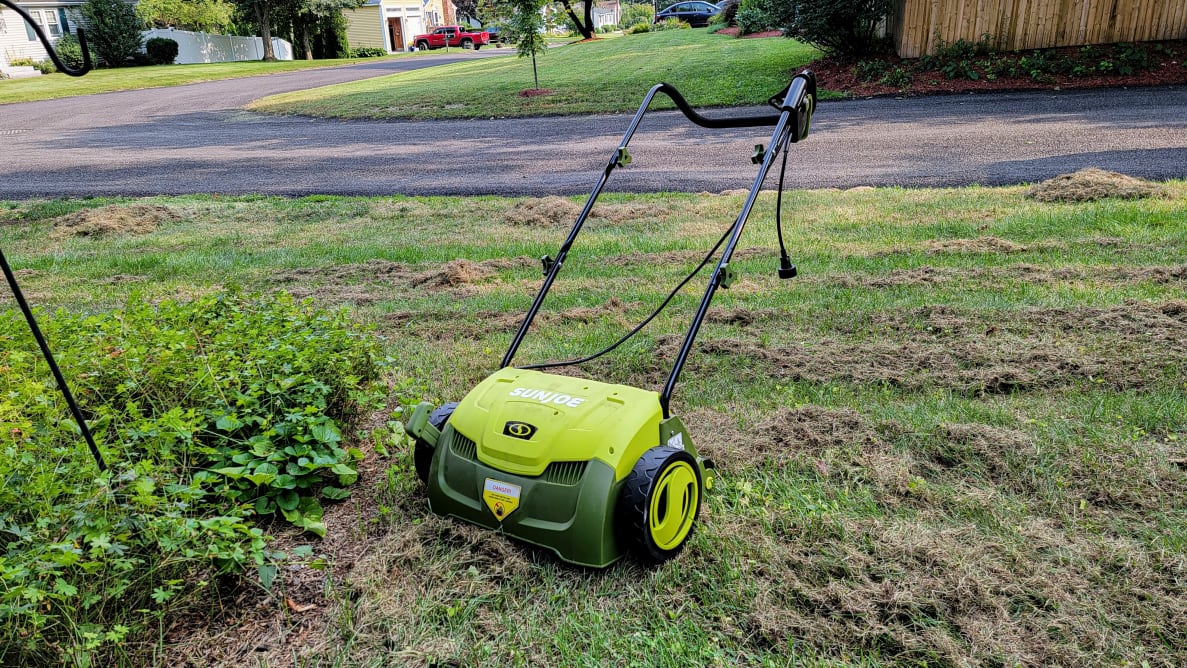Pros
-
Self-propelled
-
Efficient
-
Affordable
Cons
-
Small collection bag
-
Needs an extension cord
Review body
When I bought my home in 2018, I dove into the world of DIY lawn care—mostly because a septic replacement left us with a giant mound of mud, weeds, and nothing else.
The Sun Joe is legendary in those online circles, because it has long been one of the few affordable products on the market that can replace the need to rent a bulky, professional-grade dethatcher. With a day-long rental often costing about $80, it can quickly become more economical to just buy your own.
To see if the Sun Joe could live up to its reputation, I called it in and put it to the test on my very own lawn. I haven’t dethatched my lawn in about two years, and I have significant soil compaction in the side of my yard, so it had its work cut out for it.
Dethatching vs. scarifying vs. aeration: What’s the difference?

Dethatching is the process of mechanically removing the layer of dead plant matter that builds up in most lawns like a carpet on top of your soil. Here, you can see where the SunJoe has dethatched a strip of lawn.
What exactly is dethatching? Dethatching is the process of mechanically removing the layer of dead plant matter that builds up in most lawns like a carpet on top of your soil. While some thatch is a good thing—it can act as a natural barrier to weeds and will keep water in your soil from evaporating too quickly—with too much it’s difficult for seeds and fertilizer to make contact with your soil where they need to be.
Scarifying is effectively hardcore dethatching. Instead of scratching the surface with thin, rake-like tines, the Sun Joe’s scarifying head rolls blade-like arms over the ground to dig into the soil and rip thatch up simultaneously. It is much more disruptive to the top layer of your lawn, but it can help relieve soil compaction through some light aeration.
Ever walk on a lawn that feels hard as concrete? That’s soil compaction at work. When your soil becomes too compacted, grass seed, fertilizer, and water will just wash right off. It takes more energy for roots to grow and grass to spread, and it prevents air from reaching the root layer. It’s bad.
The best way to relieve soil compaction is to “aerate” your lawn, which involves using a machine that rolls over your lawn digging tons of little plugs of soil out.
To tell if your lawn needs aeration, just take a screwdriver and stab the ground. If it slides right in, you’re fine. If it won’t go in without forcing it, it’s time to aerate, either with a scarifier or (if your problem is more serious) a proper gas-powered aerator.
Basically, a dethatcher like this Sun Joe is like an electric lawnmower, except instead of spinning a blade that cuts your grass, it spins a wheel that has two types of attachments: a dethatcher that will effectively rake up the dead plant thatch and a scarifier that will do that and also roll into your soil and more aggressively rip up the top layer of thatch and soil.
Like a lawn mower, the dethatcher has a (very small) collection bag, which keeps the dead thatch from just falling right on top of your lawn (if you choose). Though swapping heads requires undoing a couple of bolts, it’s a pretty simple machine overall.
Your main worry here is that it runs via an electric, corded mower (meaning you’ll need a couple 50-foot extension cords). It may sound like a pain if you're used to gas-powered lawn care devices, but unless you have a truly massive lawn it'll get the job done.
About the Sun Joe AJ801E Dethatcher and Scarifer

This self-propelled dethatcher and scarifier features five depth settings.
- Power: Corded electric, 12 amp motor
- Included heads: Dethatcher, scarifier
- Material: Alloy steel and plastic
- Weight: 27 pounds
- Self-propelled?: Yes
- Cutting width: 13 inches
- Dimensions: 24 x 20 x 12.5 inches
- Starting style: Push-button instant start
What we like about the Sun Joe Dethatcher and Scarifer
When it comes to dethatching, the Sun Joe really works

Dethatching and scarifying are all great ways to tackle the kinds of problems that inevitably creep up in even the best-kept lawns.
In my testing, I first focused on my front lawn, which was unaffected by the septic replacement I mentioned earlier. It’s a fairly thick mix of perennial rye and some tall turf type fescue. In some lower areas it’s especially prone to thatch that can even cause my lawnmower to struggle.
In just two passes with the Sun Joe, I was able to remove an entire wheelbarrow full of thatch from this 600-square-foot section alone. It was intense, and it also immediately exposed the Sun Joe’s biggest problem: It removes way more thatch than you’d expect, and more than its little collection bag can handle (more on that in a bit).
The scarifying function is great for seeding
My side yard is in significantly rougher shape than the front or back. The septic removal required lots of heavy trucks and equipment to roll over the lawn, and it wasn’t sufficiently raked and top dressed when the work was done.
Making matters worse, the lawn was replaced with a type of grass called “Kentucky 31,” which is notorious for growing in ugly blades and clumping together, leaving lots of room for moss and weeds to take hold.
The result is an area I’ve had to continuously baby over the last two years to keep the weeds from taking over. Through three winters, that soil has just continued to get harder, to the point I don’t even like walking on it with bare feet, and I’m worried my kids will hurt themselves falling on it—and this is after using that professional dethatcher on it to try to dig out some plugs.
Though I’ll need to see how it holds up over time, the Sun Joe immediately ran roughshod over this part of my lawn, roughing up the grass and disturbing the top layer of soil. The machine has five depth settings, though I found that the deepest was the only one that really took care of the job.
I wound up going over this part of the lawn twice, the second time perpendicular to the first. The grass definitely looked worse for wear, but there was much more loose, soft soil on top to plant seed in.
Electric motor means minimal mess, maintenance, or hassle
While gas-powered lawn care gear is typically more powerful, electric gear has come a long way. The Sun Joe is proof of that, easily performing on par with the heavy, bulky, awkward professional dethatcher I rented in the past, despite being much lighter, much easier to use, and turning on easily without any complex—and for some people, downright impossible—pulling operation.
The Sun Joe is also easier to store, without the concern of having to make sure you either drain or stabilize any remaining gasoline before you store it for a while. For a machine you’re likely going to use a few times a year and otherwise forget about, that’s a big advantage.
What we don’t like about the Sun Joe Dethatcher and Scarifer
It may be more expensive than just renting one time
Prices vary depending on where you live, but around me you can rent an aerator or dethatcher for $50 to $80 per day. That’s certainly cheaper than the $160 to $200 you’ll pay for the Sun Joe (prices tend to fluctuate depending on the retailer), though it’s worth noting that the Sun Joe is both a dethatcher and an aerator and those rental costs will usually get you one or the other.
Of course, those gas-powered tools, while heavy, are also significantly more powerful and are better-suited if you have a lot of ground to cover, like an entire soccer or baseball field. My property is only about a quarter of an acre, and the Sun Joe made quick work of it. It could definitely handle up to an acreage of lawn.
The collection bag fills up constantly

You can operate the dethatcher without the collection bag, but you may want to then use a leaf blower to get that dead plant matter off your lawn.
I wouldn’t describe my lawn’s thatch issues as an emergency or anything, but the collection bag filled up after just one pass over 100 square feet. I have a standard walk-behind mower, and I typically have to empty the collection bag once mid-mow. With this thing just pulling up thatch I had to empty it probably 10 times in one pass of just my front lawn.
You can operate it without the collection bag—most powered dethatchers you’ll rent don’t have a collection bag at all—but you may want to then use a leaf blower to get that dead plant matter off your lawn (I also just mowed over some of it to let the lawnmower pick it up). I opted to rake everything up, which took longer than the actual dethatching.
Either way you’ll have some extra steps to worry about. One reviewer also ran it bagless and their husband had a rock shoot up and hit them where the sun didn’t shine, so be on the lookout for that.
Swapping between scarifier and dethatch modes requires extra tools
This isn’t uncommon, but may be unexpected: You’ll need a socket wrench to swap between the scarifier and dethatch modes. It’s not a difficult operation—just remove one screw with an 8mm Allen wrench bolts holding the dethatcher arms on and replace with the scarify end—but if you don’t own an Allen wrench set then you’ll need to pick one up, or pick up one of the the best starter tool kits we’ve tested that will have one.
The scarifier function doesn’t aerate extremely well

A dethatcher will effectively rake up the dead plant thatch, while a scarifier will do that and also roll into your soil and more aggressively rip up the top layer of thatch and soil.
Though the Sun Joe can match professional gas-powered dethatchers, I didn’t think the scarifying function held up to a professional core aerator. It really chops up the top layer of dirt, more so than even using a metal rake and doing it by hand, but it doesn’t go any deeper.
A full aeration will dig down 2 to 3 inches and rip up plugs of soil. That’s the only long-term solution I’d trust to relieving severe compaction. I do think that the Sun Joe’s scarifying function is sufficient to improve overseeding grass, since you don’t want grass seeds that deep in the soil anyway, but if you have bad compaction issues you may want to consider a rental still.
Should you buy it?
Absolutely—it’s the best value for anyone that regularly cares for their lawn
Most people understand the basics of lawn care: high quality location-appropriate seed, nutrient-rich fertilizer, regular mowing, and plenty of water and sunshine. But, if you want your lawn to thrive, you need to create the conditions that allow for that.
Dethatching and aerating (or in this case, scarifying) are all great ways to tackle the kinds of problems that inevitably creep up in even the best-kept lawns. If you’re going to commit to doing this kind of thing even once a year, the Sun Joe will pay for itself compared to renting other machines.
Though it’s not as powerful as the gas-powered machines you’ll rent at The Home Depot or Lowe’s, it’s lighter, more convenient, more accessible, and it dethatches extremely well. In fact, I had so much thatch come out of my lawn that it took me another 90 minutes just to rake it all up and dump it.
The “scarifying” tool was not as effective as a proper heavy-duty aerator that rips 3-inch plugs of soil out of the ground, but it was enough to relieve my lawn’s issues temporarily, and it should improve the seed-to-soil contact essential to overseeding and repairing your lawn.
Overall, anyone that wants a great lawn is going to have to tackle thatch and aeration at some point, and this is one of the best, most affordable ways to do that on a DIY budget. It’s not a perfect machine, but there’s a reason it’s proven popular and our tests show that it’s exactly as good as advertised.
Meet the tester
TJ is the former Director of Content Development at Reviewed. He is a Massachusetts native and has covered electronics, cameras, TVs, smartphones, parenting, and more for Reviewed. He is from the self-styled "Cranberry Capitol of the World," which is, in fact, a real thing.
Checking our work.
Our team is here to help you buy the best stuff and love what you own. Our writers, editors, and experts obsess over the products we cover to make sure you're confident and satisfied. Have a different opinion about something we recommend? Email us and we'll compare notes.
Shoot us an email


